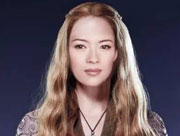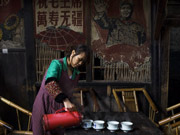

2. Characteristics of TCM
During its course of development spanning a couple of millennia, TCM has kept drawing and assimilating advanced elements of natural science and humanities. Through many innovations, its theoretical base covered more ground and its remedies against various diseases expanded, displaying unique characteristics.
First, setting great store by the holistic view. TCM deems that the relationship between humans and nature is an interactive and inseparable whole, as are the relationships between humans and the society, and between the internal organs of the human body, so it values the impacts of natural and social environment on health and illness. Moreover, it believes that the mind and body are closely connected, emphasizing the coordination of physical and mental factors and their interactions in the conditions of health and illness.
Second, setting great store by the principle of harmony. TCM lays particular stress on the importance of harmony on health, holding that a person's physical health depends on harmony in the functions of the various body organs, the moderate status of the emotional expression, and adaption and compliance to different environments, of which the most vital is the dynamic balance between yin and yang. The fundamental reason for illness is that various internal and external factors disturb the dynamic balance. Therefore, maintaining health actually means conserving the dynamic balance of body functions, and curing diseases means restoring chaotic body functions to a state of coordination and harmony.
Third, emphasis on individuality. TCM treats a disease based on full consideration of the individual constitution, climatic and seasonal conditions, and environment. This is embodied in the term "giving treatment on the basis of syndrome differentiation." Syndrome differentiation means diagnosing an illness as a certain syndrome on the basis of analyzing the specific symptoms and physical signs collected by way of inspection, auscultation &olfaction, inquiry, and palpation, while giving treatment means defining the treatment approach in line with the syndrome differentiated. TCM therapies focus on the person who is sick rather than the illness that the patient contracts, i.e., aiming to restore the harmonious state of body functions that is disrupted by pathogenic factors.
Fourth, emphasis on preventative treatment. Preventative treatment is a core belief of TCM, which lays great emphasis on prevention before a disease arises, guarding against pathological changes when falling sick, and protecting recovering patients from relapse. TCM believes that lifestyle is closely related to health, so it advocates health should be preserved in daily life. TCM thinks that a person's health can be improved through emotional adjustment, balanced labor and rest, a sensible diet, and a regular life, or through appropriate intervention in the lifestyle based on people's specific physical conditions. By these means, people can cultivate vital energy to protect themselves from harm and keep healthy.
Fifth, simplicity. TCM doctors diagnose patients through inspection, auscultation &olfaction, inquiry, and palpation. In addition to medication, TCM has many non-pharmacological alternative approaches such as acupuncture and moxibustion, tuina (massage), cupping and guasha (spooning). There is no need for complex equipment. TCM tools, for example, the small splints used in Chinese osteopathy, the spoons used in guasha, or the cups used in cupping therapy, can draw from materials close at hand, so that such treatments can spread easily.
3. TCM's Contributions
TCM is an important component and a characteristic feature of traditional Chinese culture. Applying such principles as "man should observe the law of the nature and seek for the unity of the heaven and humanity," "yin and yang should be balanced to obtain the golden mean," and "practice of medicine should aim to help people," TCM embodies the core value of Chinese civilization. TCM also advocates "full consideration of the environment, individual constitution, and climatic and seasonal conditions when practicing syndrome differentiation and determining therapies," "reinforcing the fundamental and cultivating the vital energy, and strengthening tendons and bones," and "mastership of medicine lying in proficient medical skills and lofty medical ethics," all concepts that enrich Chinese culture and provide an enlightened base from which to study and transform the world.
TCM originated in the Chinese culture. It explains health and diseases from a macro, systemic and holistic perspective. It shows how China perceives nature. As a unique form of medicine, TCM exercises a profound influence on the life of the Chinese people. It is a major means to help the Chinese people maintain health, cure diseases, and live a long life. The Chinese nation has survived countless natural disasters, wars and pestilences, and continues to prosper. In this process, TCM has made a great contribution.
Born in China, TCM has also absorbed the essence of other civilizations, evolved, and gradually spread throughout the world. As early as the Qin and Han dynasties (221 BC-AD 220), TCM was popular in many neighboring countries and exerted a major impact on their traditional medicines. The TCM smallpox vaccination technique had already spread outside of China during the Ming and Qing dynasties (1368-1911). The Ben Cao Gang Mu (Compendium of Materia Medica) was translated into various languages and widely read, and Charles Darwin, the British biologist, hailed the book as an "ancient Chinese encyclopedia." The remarkable effects of acupuncture and moxibustion have won it popularity throughout the world. The discovery of qinghaosu (artemisinin, an anti-malaria drug) has saved millions of lives, especially in developing countries. Meanwhile, massive imports of medicinal substances such as frankincense and myrrh have enriched TCM therapies.
 |  |

 Who Will Fit The Chinese Roles In Game Of Thrones?
Who Will Fit The Chinese Roles In Game Of Thrones? China's Hubei Shennongjia added to World Heritage List
China's Hubei Shennongjia added to World Heritage List Cute Dog At Fruit Stand Becomes Latest Internet Sensation
Cute Dog At Fruit Stand Becomes Latest Internet Sensation Top 10 livable Chinese cities
Top 10 livable Chinese cities The last primitive tribe in China
The last primitive tribe in China China's first intelligent security robot debuts in Chongqing
China's first intelligent security robot debuts in Chongqing A Total of 3,552 Subscribers Vanish In Two Days; YouTube Closes All Doors to Users’ Inquiries
A Total of 3,552 Subscribers Vanish In Two Days; YouTube Closes All Doors to Users’ Inquiries Out of this world! Futuristic UFO-shaped yacht has its own garden and a stunning underwater viewing deck
Out of this world! Futuristic UFO-shaped yacht has its own garden and a stunning underwater viewing deck An old tea house in Chengdu
An old tea house in Chengdu Furious Customer Crushes All the Buns from Vendor Just Because He Was Given the Wrong Flavor
Furious Customer Crushes All the Buns from Vendor Just Because He Was Given the Wrong Flavor